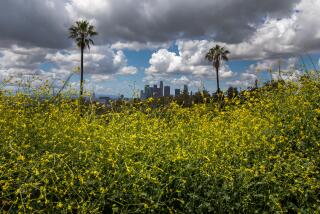Time to make the beds
- Share via
It’s FINALLY WARM enough to plant tomatoes in most parts of the Southland, or petunias, or bougainvillea, citrus and other warmth-loving plants. There’s no longer any danger of frost nipping new plantings, and putting them in now gives them a chance to become established before the heat of summer arrives.
Citrus season
This is perhaps the best time to plant citrus, from lemons to oranges. Keep new plants adequately watered and lightly fertilize every couple of weeks, which is the regimen at the growers. To make sure the root ball gets wet, build a watering basin by mounding soil about 4 inches high to make a circular dam that will funnel water to the roots. Fill it twice each time you water. Mature citrus, on the other hand, need little or no fertilizer (if leaves are left on ground as a mulch) and infrequent irrigations. Watering too often can kill them.
Too-big vines
If you need to make a bougainvillea smaller or simply tidy one up, now is the time. They’ll quickly recover in the warming weather, and pruning will barely affect the bloom.
Water world
Gardens that have been coasting on winter rainfall and the occasional irrigation will now need more, but don’t overdo it. Deep, infrequent irrigations are the way to water most landscape plants, including all trees and shrubs. The exception: New plantings need watering once or twice a week, maybe even every day during the first week or two. Spritzing plants with your thumb over the hose may cool them off but it doesn’t count as irrigation. Use soakers, drip or sprinklers, even the kind you screw on a hose.
Roses on parade
The biggest, most eye-popping bloom of the year comes early in the month. As flowers fade, cut them off along with enough stem so that only two “eyes” or buds remain on the individual branch that flowered, or make cuts just above a strapping five-part leaf. Cutting this much stem makes sure that the next round of blooms is nearly as impressive. Fertilize after each round. Watch for the tiny holes in leaves caused by sawfly larva (rose “slugs”) and control organically with horticultural oil sprays or with the systemic Imidacloprid (Bayer Rose & Flower Insect Killer).
Mow, sow or sod
In fall, many scatter seed of winter ryegrass to cover the dormancy of Bermuda. Because rye grows taller than Bermuda grass, mowers are set to cut higher; as rye begins to fade in spring, mowers should be reset so they again cut within an inch of the ground. This will encourage the greening of the low-growing Bermuda grass and phase out the rye. This is also a good month to sow seed of such cool-season lawn grasses as tall fescue. Sod can be installed in almost any month.
Produce production
This is the month to plant the summer vegetable garden, including beans, beets, carrots, corn, cucumbers, melons, peppers, pumpkins, squash, sunflowers, Swiss chard and, of course, tomatoes. And maybe a little basil to go with the tomatoes. Remember to plant tomatoes deep (something that should never be done with other plants). Pinch off the lower leaves and bury much of the stem; roots will sprout the entire length. Provide a sturdy and tall support for tomatoes, preferably 6 feet of welded wire.
Bulbs take their bows
Many spring bulbs have finished blooming and though the conventional advice is to leave the browning foliage, some gardeners have discovered it’s not necessary, except perhaps with daffodils. On daffodils, let foliage completely brown, but on other bulbs, cut it off with scissors -- don’t yank -- as it become untidy.






